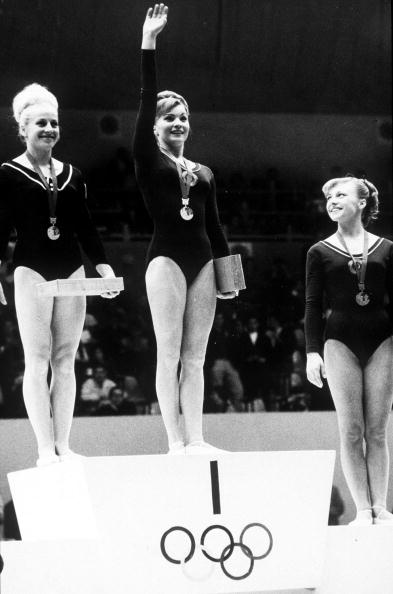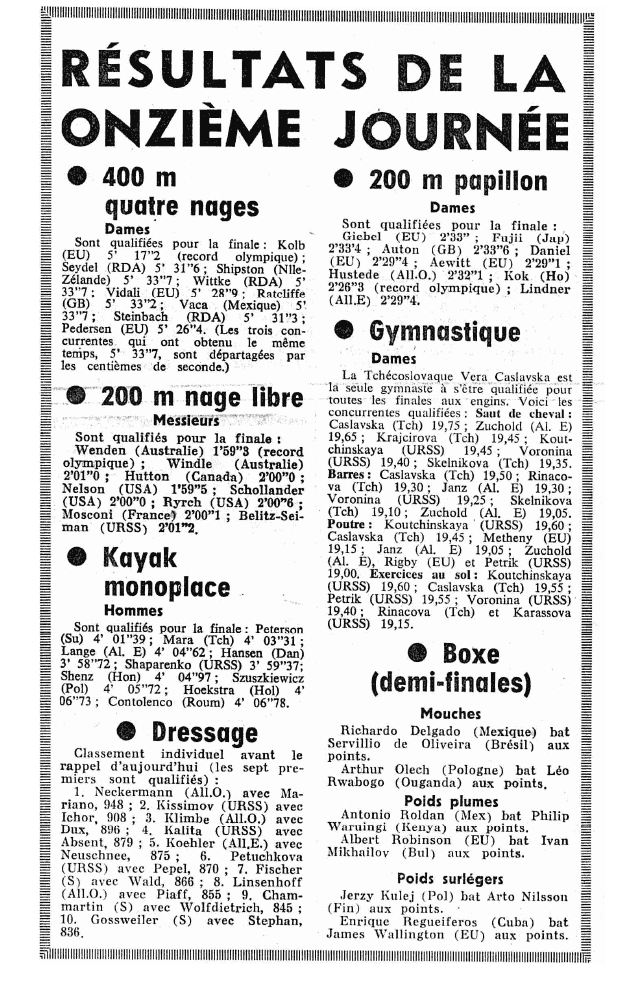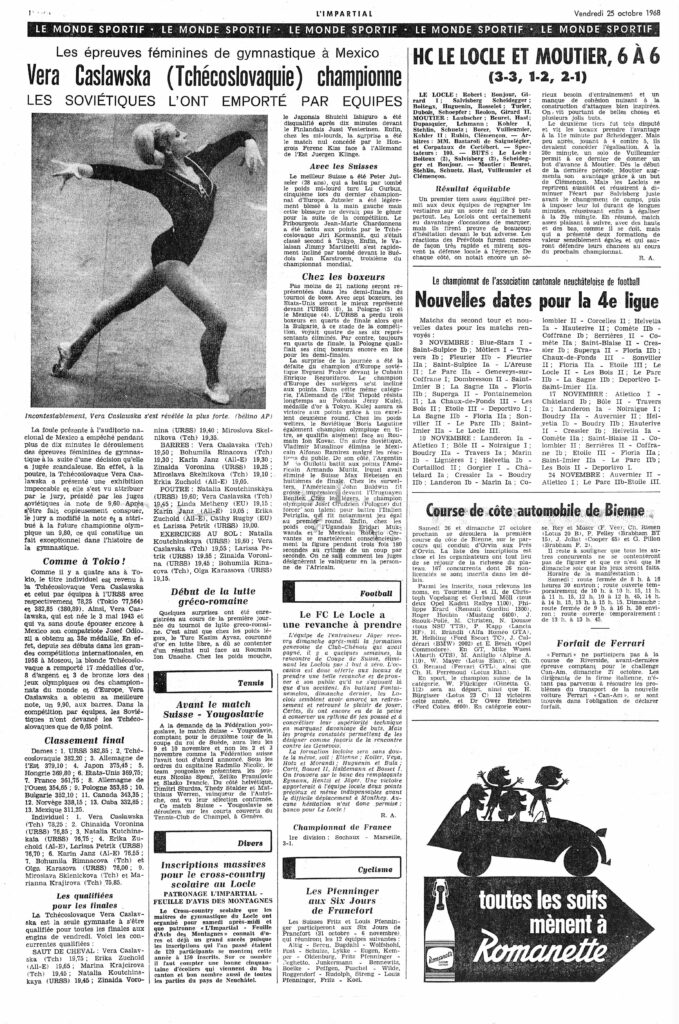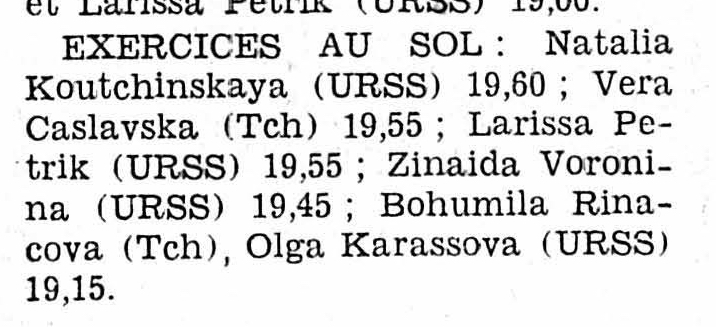As gym nerds, we’ve heard the story about the 1968 floor exercise final. It goes something like this: “Soviet Larisa Petrik’s preliminary scores were mysteriously upgraded, enabling her to tie Věra Čáslavská for the gold medal on floor.”
Well, the story is more complicated, and the sinister undertones aren’t true. The judging scandal is a myth. Plain and simple.
Let’s take a look at what happened by looking at primary resources from the time.

TL;DR
Reminder
Before we dive into the archives, here’s a quick reminder about how event finals worked in 1968.
Only six gymnasts qualified for event finals. Qualification for finals was based on the compulsory *and* optional scores on each event.
Your final score was the average of your compulsory and optional scores + the score for your routine during event finals.
Okay, with that out of the way, let’s look at the archives…
What are the facts?
On October 25, 1968, the Swiss newspaper L’Express printed the qualifiers for event finals with their scores.

As did the Swiss newspaper L’Impartial.


Heading into finals, Čáslavská and Petrik were tied behind Kuchinskaya.
- Natalia Kuchinskaya (URS) 19.60 (9.800 average)
- Věra Čáslavská (TCH) and Larisa Petrik (URS) 19.55 (9.775 average)
Adding the Prelim Scores to the Finals Scores
Both Čáslavská and Petrik scored 9.900s during finals, while Kuchinskaya scored a 9.850. When you add them to the average from prelims, you get the following scores:
| Name | Prelims Total | Prelims Average | Finals | Total Score |
| 1T. Čáslavská | 19.550 | 9.775 | 9.900 | 19.675 |
| 1T. Petrik | 19.550 | 9.775 | 9.900 | 19.675 |
| 3. Kuchinskaya | 19.600 | 9.800 | 9.850 | 19.650 |
In other words, when we use the prelims scores published in Swiss newspapers on the day of the event finals, Čáslavská and Petrik should have tied for the gold medal. The final podium was correct.
So, what happened? Why have gym nerds claimed — for decades — that something sinister happened?
It has to do with gym nerds’ beloved Gymnastics’ Greatest Stars, and the production team’s incorrect interpretation of the events.
The Meet Officials’ Big Mistake
Let’s rewatch the footage from Gymnastics’ Greatest Stars. As we do, ignore Bart Conner’s voiceover for now. Listen, instead, to the original broadcast commentary so that we can get an idea of what was happening at the time — not the retrospective interpretation that Conner offered.
Scores were circulated
Before floor finals, the event organizers circulated the qualifying scores. (But they didn’t realize that they had circulated the wrong qualifying score for Petrik.)
Based on the scores circulated before the floor final, Čáslavská thought she was the outright winner.
According to the scores that the event officials circulated, when Čáslavská scored a 9.900, she thought that she had out-scored Kuchinskaya and won the gold medal.
Neither Čáslavská nor the commentators knew that Petrik actually had a 9.775 avg. from prelims and that Petrik’s 9.900 tied the two gymnasts.
Then, the event officials *corrected* their mistake; they did not *change* the prelim scores
When the event officials realized their mistake, they updated and corrected Petrik’s qualifying scores to the right scores (a 9.775 avg.). That resulted in a tie between Čáslavská and Petrik.
Note: The circulation of the incorrect scores was a known problem. Meet organizers had similar issues during the 1967 Little Olympics.
Bart Conner’s Voiceover: The Origin of a Myth
Okay, now listen to the segment from Gymnastics’ Greatest Stars with Conner’s voiceover.
Decades later, Bart Conner’s voiceover script injected sinister undertones
Conner’s voiceover — “Politics would enter the Games for the second time” — makes it sound as if there were Soviet shenanigans afoot — as if the judges altered Petrik’s scores from prelims at the last minute so that Petrik could tie Čáslavská.
🚨 But, but, but: As we have seen, that’s not what happened. 🚨
Yes, a sinister changing of the scores fit the Cold War narrative of Gymnastics’ Greatest Stars.
Yes, the event officials majorly botched things when they circulated the wrong scores for Petrik.
Yes, many felt that there was questionable judging at the 1968 Olympic Games, and for decades, this moment seemed like a concrete way to prove that politics interfered with the results.
However, when the meet officials changed Petrik’s scores, they didn’t invent magical numbers; they simply changed them to the correct scores — the ones Petrik received during the compulsories and optionals.
Were politics involved?
Not in the way that Conner’s voiceover script implies.
I have yet to find a 1968 newspaper article that posits that the judges altered the prelim scores to boost Petrik to the top of the podium. That narrative was invented after the fact.
That said, the Dutch newspaper Trouw suggested that Čáslavská should have received a 10.0. (A 10.0 would have given her the gold medal outright.)
Tweemaal moest Vera terugkomen op het podium, eer het publiek bereid was gevolg te geven aan het verzoek om stilte. De ideale waardering “tien,” die voor dit juweel van turnkunst zonder meer gegeven had mogen worden, verscheen niet op het electronische scoreboard.
Trouw, Oct. 28, 1968
And earlier in the Trouw article, the Dutch newspaper suggested that the results of the women’s competition at the Games were tinged by politics.
In het schitterende Auditorio Nacional met zijn 27,000 zitplaatsen een ideale turntempel, heeft zich een verbitterd prestige duel afgespeeld tussen Tsjechoslowakije, Rusland en Oost-Duitsland. In dit gevecht, waarin ook politieke achtergronden een duidelijke rol speelden, heeft Rusland dan wel zijn in Melbourne, Rome en Tokio veroverde titels in het landenklassement geprolongeerd maar Tsjechoslowakije werd door Vera Casclavska dé grote triumfator.
Trouw, Oct. 28, 1968
If political shenanigans happened behind the scenes, they were more subtle. Perhaps politics prevented Čáslavská from receiving a 10.0. But there wasn’t an overt upgrading of Petrik’s scores to ensure that a Soviet gymnast would win gold on floor.
Back to the 1966 World Championships
That’s all for now. We’ll eventually get to the 1968 Olympics in its entirety, but I felt compelled to dispel the myth about Petrik’s floor scores sooner rather than later. For some reason, that myth has cropped up a lot in recent days.
And look, I am sure that I propagated this myth at various points in my life because I simply regurgitated what I learned from Gymnastics’ Greatest Stars. But when I started this site and dove into the archives, I quickly realized my mistake.
P.S. But what about the book Women’s Gymnastics: A History?
I’m putting this as a P.S. because we are heading deep into the weeds here. That said, I know that some gym nerd out there is going to bring this up.
According to Minot Simons’s book, Petrik scored a 9.50 on floor during the optionals portion of the competition.
That would mean that Petrik scored a 10.05 on her compulsory routine to reach a 19.550 (9.775 avg.) on floor. Indeed, if those scores were correct, something sinister had to have happened because you couldn’t score a 10.05 at the time.
But, but, but: Minot Simons II made a mistake. In his chapter on the 1968 Olympics, he switched the vault and floor scores for the Soviet gymnasts in the optionals competition. Petrik scored a 9.85 on floor and a 9.50 on vault — not vice versa. Similarly, Kuchinskaya scored a 9.85 on floor and a 9.70 on vault — not vice versa.
More on 1968
6 replies on “1968: The Myth of Petrik’s Floor Scores in Mexico City”
Great detective work, thank you
Thank you for this blog! When I was in 11th grade I begged my teacher to let me write an essay investigating the link between communism and great gymnastics! He said no. Because there wasn’t much “scholarly research” on the topic. Uncle Tim, you are definitely a scholar! Keep up the gymnastics history for the gym nerds!
love it!
Thanks Uncle Tim! Love your new website. This is truly groundbreaking information!
Do you have the links for these sources? I would like to be able to review and cite them myself. Thank you!
Also another fact is she tied Zuchold for 4th place in the AA. Since new life did not exist her AA placing would be different also. Her 4th place tie could only be accomplished if her floor prelims score was 19.55.